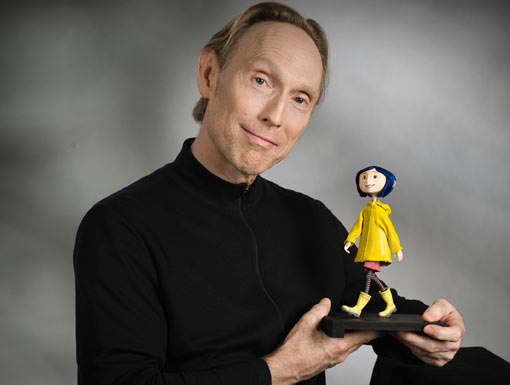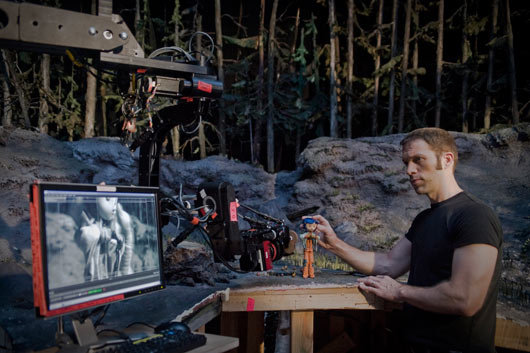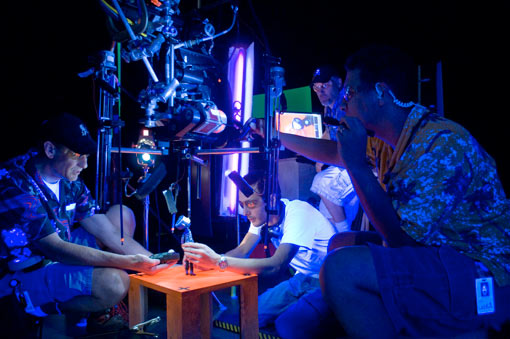Bringing Digital 3D to Stop-Motion Animation

Film & Video spoke with Selick on the eve of Coraline‘s Feb. 6 debut.
Henry Selick: I responded to it as a modern but classic dark fairy tale. I responded to the idea that we all wish for a better version of our lives, wish we had different parents or whatever. I like the character of Coraline, an ordinary girl who doesn’t have fighting skills or super powers or is a super genius. She’s an ordinary girl who comes up against extraordinary evil and manages to win.
At least 90 percent is practical: virtually every creature [and] every character as well as movements of trees and blowing leaves, blades of grass, spattering mud, raindrops, water coming out of the shower. The mouse circus is replacement animation [different mice are used to convey the action as opposed to one flexible puppet]. All the Scottie dogs are real. It was very much a decision to keep as much of it as hand-made and real as possible. We thought, let’s play to the strengths of stop-motion.
CG was there to extend what we do and to help glue the world together and make things a little more seamless. We have an incredible VFX supervisor [Brian Van’t Hul at LAIKA] who knows how to do practical and CG effects. We did some compositing, some manipulation, [and] some repair work. We did do replacement face animation for Coraline and both the mothers. We did it that way because we were going for more expressive faces and couldn’t have new heads for every variable. Splitting the upper and lower face extended the range. The computer did the in-between shapes. In the past, they would have been in-betweened by hand.
What was done to make sure that the practical and the digital blend seamlessly?
There is very little raw CG in the film to blend. There’s really only one scene that’s maybe a little too obviously CG. When the ghost children are golden angels, the background was created in CG, inspired by Van Gogh’s Starry Night.

Writer/director Henry Selick. (Photo by Kelvin Jones; (C) Focus Features)
Are we seeing new stop-motion techniques or technologies in Coraline?
Absolutely. We’re not total Luddites. We shot the film digitally – the first time for me. There are many reasons to do this but the best for me was the workflow-to be able to shoot a test and see it immediately rather than waiting for dailies. It made the whole process more fluid. I could do dailies four times a day and at the end, all day. It was liberating for that flow of imagery to have been enhanced so much by shooting digitally.
To shoot in 3D, we used these special medical cameras from Redlake [the MegaPlus II]. When you shoot in 3D, you need a left eye/right eye and if you’re shooting puppets, the scale has to be much smaller [than live action]. We couldn’t get cameras and lenses that close together, so we used a camera to shoot one eye and moved it over very, very slightly to get the other eye. It is the same amount of work for the animators. The puppets stand still; they’re very obedient. But it’s double the amount of images. When the 3D was more extreme, the clean-up work was double the work.

Lead animator Travis Knight (Photo by Kelvin Jones; (C) Focus Features)
What was behind the decision to go 3D with Coraline? What did you learn from the 3D version of Nightmare?
I have a long history with 3D. I did a 3D rock video 20 years ago for the Viewmaster Corporation, the little picture wheels that children use. They were trying to branch out, and RealD CTO Lenny Lipton was the guy whose technology we used, so I met him 20 years ago. I would check in with Lenny every few years to see his latest developments; I knew he’d take this technology farther than anyone else.
There’s a sense we’re not really sharing the best version of the film with people by shooting it flat. The essence of stop motion is that it’s real. It’s not drawn or created in the computer, and the audience won’t necessarily know that. So my desire to capture it that way goes back to Nightmare. With Coraline, the decision to shoot in 3D coalesced over the idea that the movie needs a device to enhance this other world. As Alice in Wonderland discovered, it was a world of color rather than B&W, and this story needed something visually. And Lenny’s tinkering led to the modern 3D system with RealD. All those different threads came together. We shot tests and saw it was perfect for Coraline.

Assistant cameraman Tim Taylor (left), animator Chris Tootell (center), lighting and cameraman Chris Peterson (far back) and electrician James Wilder Hancock (right). (Photo by Galvin Collins; (C) LAIKA Inc.)
How did you use 3D in Coraline?
There was a learning process – mainly not to overuse it. We ultimately used it to help draw the audience into the Other world as Coraline is being drawn into the Other world. The sets in the Other world are actually deeper. In her real world, it’s crushed space with steeply raked floors. For example, the kitchen in her real world is one foot deep. The kitchen in the Other world is four feet deep. I wanted to use 3D in a more subtle way to show what Coraline is going through, that there’s a sense of spaciousness in that Other world. We have a few shots where things poke you in the eye, but when the Other world goes wrong, we crank up the 3D almost to an uncomfortable level to enhance the storytelling.
Do you have a philosophy about stereoscopic 3D – how and when it should be used?
The fact that stop-motion animation is real is what separates it from other forms of animation, and shooting it in 3D is the best way to capture that fact. People can see old stop-motion with Ray Harryhausen’s films and it can be moving and exciting, but when you shoot it in 3D it adds a vitality, it brings the puppets to life.
What are your thoughts about 3D CG?
I’ve tried all the different forms of animation. I was a pencil animator at Disney [and] I’d done early cut-out work. I was exposed to Harryhausen and Lotte Reiniger at an early age. I definitely sparked to those things in addition to what was coming out of Disney and Warner Bros. I got a grant in the late 1970s from the National Endowment of the Arts and did life-sized stop-motion characters and I made the choice that, given the choice, that would be the medium I’d work in. There’s an electricity to it. There’s a vibrancy for the animator wielding a real puppet, something that’s actually there. Coaxing a performance.
For More Info:
Redlake Digital Imaging Systems
Laika
Coraline official site
How healthy is animation that’s not computer generated? Does it have a future or will it be relegated to student and art projects?
2D was even shut down at Disney a number of years ago, very foolishly I think, after they made Lilo & Stitch, one of the best 2D films ever. The funny thing is that the guy responsible for the success of 3D CG, John Lasseter, has brought 2D back to Disney. They’re doing a hand-drawn film [The Princess and the Frog, aka The Frog Princess].
So there’s a desire for other sorts of animation that now people in power have the ability to revive. Tim Burton is going to do another stop-motion feature, called Frankenweenie. Wes Anderson is doing Fantastic Mr. Fox. Stuff is happening. Stop-motion will never stride forward as the dominant form, but it’ll keep bubbling along and never quite go away.
Did you enjoy this article? Sign up to receive the StudioDaily Fix eletter containing the latest stories, including news, videos, interviews, reviews and more.










Leave a Reply